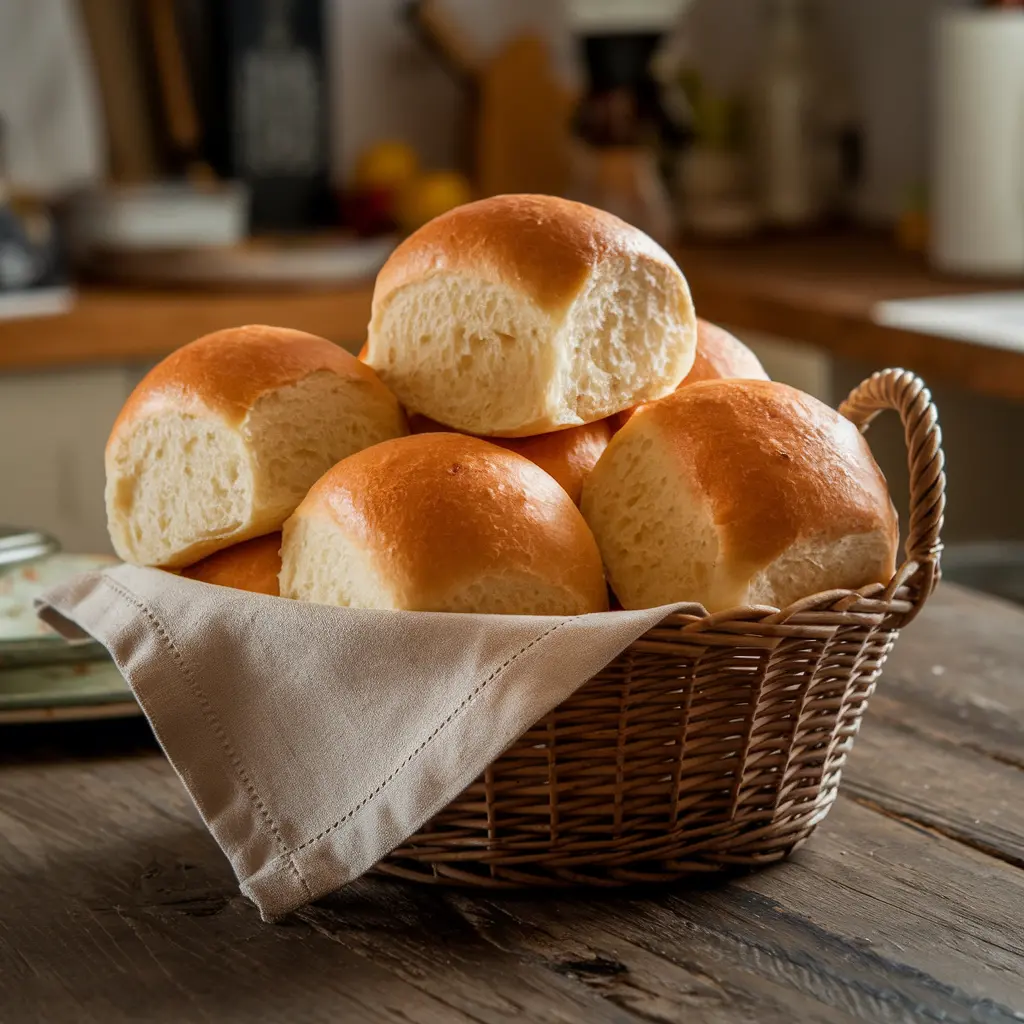Dinner rolls are a classic comfort food, cherished for their soft, fluffy texture and buttery flavor. Whether you’re hosting a holiday feast or looking to elevate a weeknight meal, homemade dinner rolls are the perfect accompaniment. In this article, we’ll explore how to make dinner rolls from scratch, including essential ingredients, step-by-step instructions, and expert tips to ensure delicious results every time.
Table of contents
What Are Dinner Rolls?
Dinner rolls are small, round, and soft bread rolls typically served alongside main courses at meals. Known for their light, fluffy texture and slightly sweet flavor, they are a staple in many households, especially during festive gatherings like Thanksgiving, Christmas, and family dinners.
Definition and Characteristics
Dinner rolls are yeast-based bread rolls made with simple ingredients such as flour, water or milk, yeast, sugar, and butter. They have a golden-brown exterior with a soft, airy interior, making them ideal for soaking up sauces, gravies, or spreading with butter.
History of Dinner Rolls
The origin of dinner rolls dates back to ancient times when bread-making began. Modern dinner rolls as we know them evolved in European bakeries and gained popularity in the United States during the 19th century. Variations like Parker House rolls and cloverleaf rolls are iconic examples rooted in American culinary history.
Types of Dinner Rolls
Dinner rolls come in various forms depending on the preparation method and shaping technique:
- Classic Round Rolls: The most common style, shaped into even balls.
- Parker House Rolls: Folded and baked in a way that creates a signature buttery interior.
- Cloverleaf Rolls: Made by placing three small dough balls in a muffin tin, forming a clover-like shape.
- Pull-Apart Rolls: Baked together in a single pan, making them easy to tear apart when served.
Essential Ingredients for Dinner Rolls
To create perfect dinner rolls, you need a few key ingredients that work together to build structure, flavor, and texture. Each ingredient plays a crucial role in ensuring soft, fluffy, and golden-brown rolls.
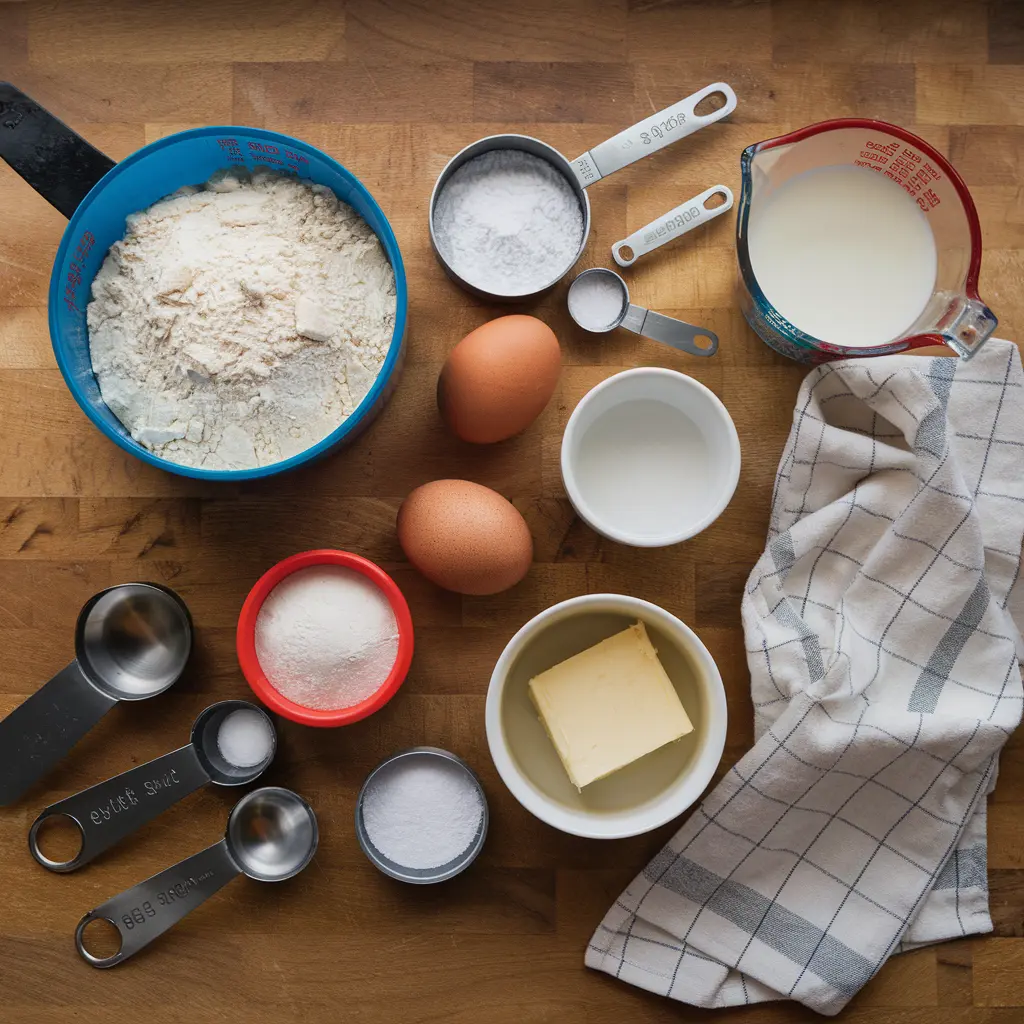
Core Ingredients and Their Functions
- Flour
- Type: All-purpose flour or bread flour.
- Why It’s Important: Flour provides structure due to its gluten content. Bread flour yields a chewier texture, while all-purpose flour makes lighter rolls.
- Yeast
- Type: Active dry yeast or instant yeast.
- Why It’s Important: Yeast is responsible for fermentation, causing the dough to rise and become light and airy.
- Milk
- Type: Whole or 2% milk (or dairy-free alternatives).
- Why It’s Important: Milk enriches the dough, giving the rolls a tender, moist texture. Warm milk also activates the yeast.
- Butter
- Type: Unsalted butter (melted or softened).
- Why It’s Important: Butter adds moisture and richness, enhancing both taste and texture.
- Sugar
- Type: Granulated sugar (or honey).
- Why It’s Important: Sugar feeds the yeast, aiding in fermentation, and adds mild sweetness.
- Eggs
- Why They’re Important: Eggs provide structure, help with rising, and add richness and color to the rolls.
- Salt
- Why It’s Important: Salt balances sweetness, enhances flavor, and strengthens the dough’s gluten structure.
- Water
- Why It’s Important: Water hydrates the flour, activates the yeast, and creates the dough’s structure.
Optional Add-Ins and Substitutions
- Herbs & Spices: Rosemary, thyme, or garlic powder for extra flavor.
- Cheese: Grated Parmesan or cheddar for a savory twist.
- Sweeteners: Swap sugar with honey or maple syrup for a different sweetness profile.
Step-by-Step Guide to Making Dinner Rolls
Making dinner rolls from scratch is easier than it seems. Follow these detailed steps to create perfectly soft and fluffy rolls every time.
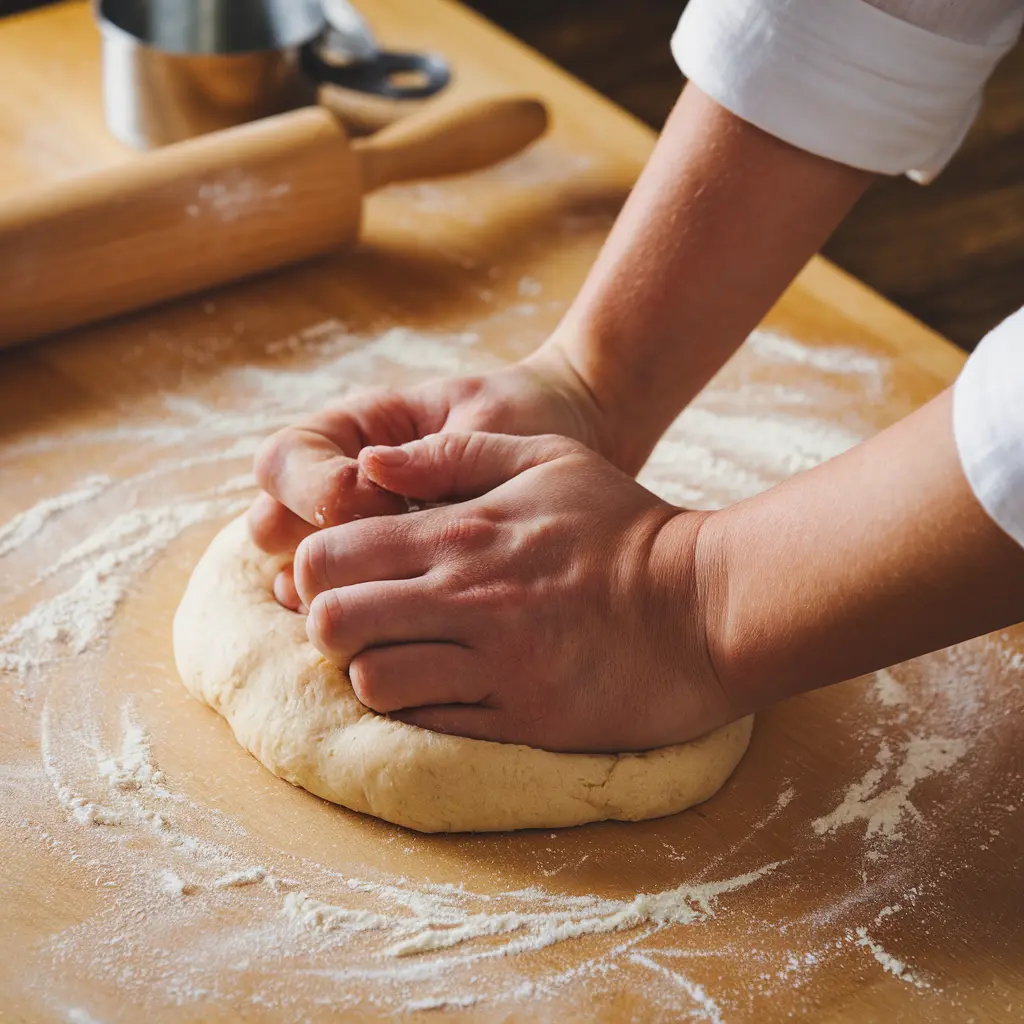
Preparing the Dough
- Activate the Yeast:
- Warm the milk to around 100-110°F (37-43°C). Add sugar and yeast, stirring gently. Let it sit for 5-10 minutes until foamy, indicating that the yeast is active.
- Mix the Dough:
- In a large mixing bowl, combine the yeast mixture, softened butter, eggs, and salt. Gradually add flour, one cup at a time, mixing until a sticky dough forms.
- Knead the Dough:
- Knead the dough by hand or with a stand mixer for 8-10 minutes until smooth and elastic. The dough should be slightly sticky but manageable.
Proofing the Dough
- First Rise:
- Place the dough in a greased bowl, cover it with a clean towel or plastic wrap, and let it rise in a warm spot for 1-2 hours or until it doubles in size.
- Punch Down the Dough:
- Gently punch down the dough to release air bubbles.
Shaping the Rolls
- Divide the Dough:
- Turn the dough onto a lightly floured surface. Divide it into equal portions (about 12-16 rolls, depending on preferred size).
- Shape the Rolls:
- Roll each portion into a smooth ball by cupping your hand around the dough and applying light pressure.
- Second Rise:
- Place the rolls on a greased baking sheet or pan, spacing them evenly. Cover and let them rise for another 30-45 minutes until doubled in size.
Baking the Rolls
- Preheat the Oven:
- Set the oven to 375°F (190°C).
- Brush with Butter:
- Lightly brush the tops of the rolls with melted butter or an egg wash for a golden finish.
- Bake:
- Bake for 15-20 minutes until golden brown and cooked through. Use a kitchen thermometer to check if the internal temperature reaches 190-200°F (88-93°C).
- Cool and Serve:
- Allow the rolls to cool slightly before serving. Brush with more butter for added shine and flavor.
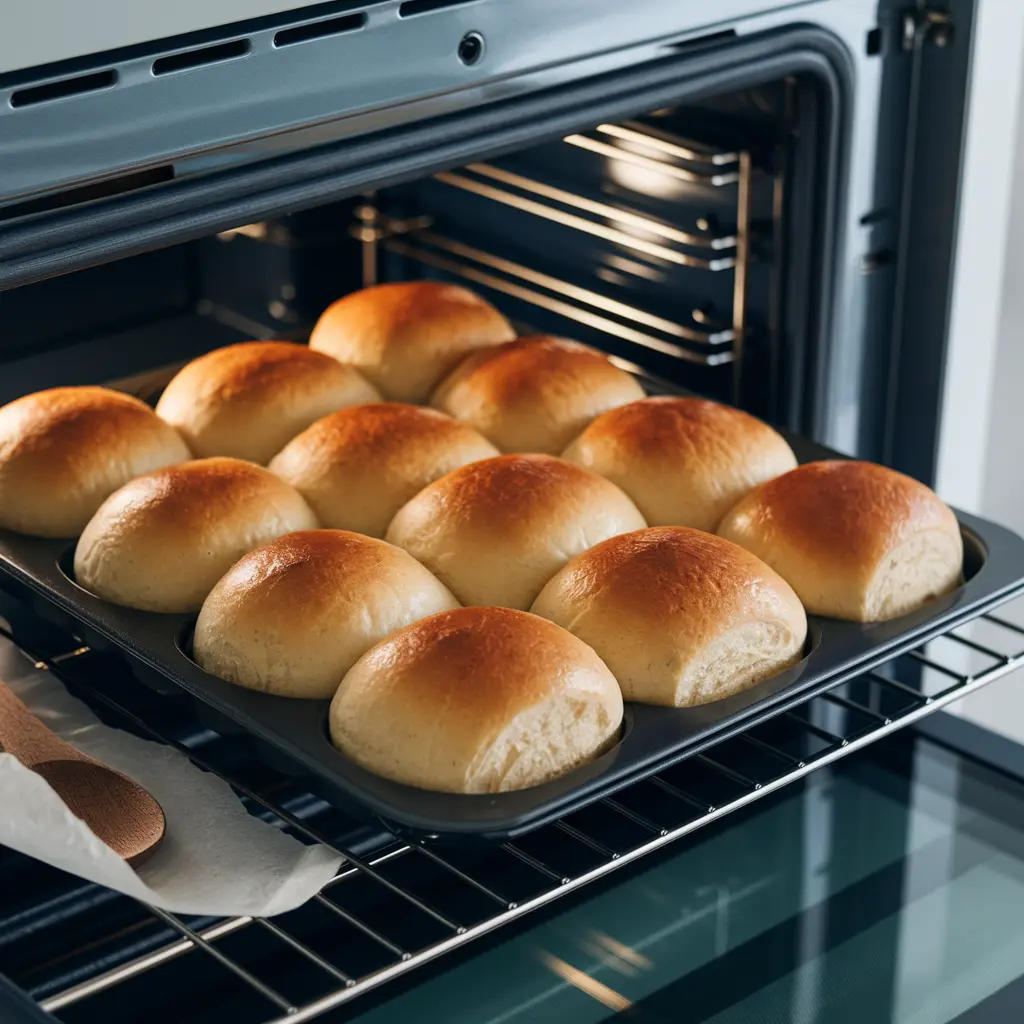
Tips for Success When Making Dinner Rolls
Creating perfect dinner rolls requires attention to detail. Here are some expert tips and tricks to ensure your rolls come out soft, fluffy, and delicious every time.
Common Mistakes and How to Avoid Them
- Using Cold Ingredients:
- Why It’s a Problem: Cold ingredients can slow down yeast activity, making the dough rise slowly.
- Solution: Use room-temperature eggs and warm milk (100-110°F) to activate the yeast properly.
- Skipping the First Proof:
- Why It’s a Problem: Skipping the first rise leads to dense rolls.
- Solution: Allow the dough to double in size during the first proof for a light and airy texture.
- Not Kneading Enough:
- Why It’s a Problem: Insufficient kneading prevents the dough from developing enough gluten for structure.
- Solution: Knead the dough for at least 8-10 minutes by hand or mixer until smooth and elastic.
- Overproofing the Dough:
- Why It’s a Problem: Overproofed dough can collapse and result in flat rolls.
- Solution: Allow the second rise only until the rolls double in size, typically 30-45 minutes.
- Incorrect Oven Temperature:
- Why It’s a Problem: Baking at too low or too high a temperature affects the texture and browning.
- Solution: Preheat the oven to 375°F (190°C) and use an oven thermometer for accuracy.
Expert Baking Tips
- Use the Windowpane Test:
- After kneading, stretch a small piece of dough between your fingers. If it forms a thin, translucent “window,” the dough is ready.
- Create a Warm Rising Environment:
- Place the covered dough in a slightly warm oven or near a sunny window to encourage faster rising.
- Brush with Butter Twice:
- Brush the rolls with melted butter both before and after baking for a rich, buttery flavor.
- Use Uniform Dough Sizes:
- Weigh the dough portions on a kitchen scale to ensure even baking and presentation.
Troubleshooting Tips
- Rolls Too Dense:
- Cause: Under-kneading or not enough rising time.
- Fix: Knead longer and allow more time for the first proof.
- Rolls Too Dry:
- Cause: Overbaking or using too much flour.
- Fix: Bake for a shorter time and measure flour accurately.
- Rolls Not Rising:
- Cause: Inactive yeast or cold ingredients.
- Fix: Ensure yeast is fresh and milk is warm enough.
Recipe Variations for Dinner Rolls
Dinner rolls are incredibly versatile and can be adapted to fit different dietary preferences and flavor profiles. Here are some popular variations that add unique twists to the classic recipe.
Healthier Dinner Roll Options
- Whole Wheat Rolls:
- Ingredients Adjustment: Substitute half or all of the all-purpose flour with whole wheat flour.
- Benefits: Adds fiber, vitamins, and a slightly nutty flavor.
- Tip: Use a mix of whole wheat and bread flour to maintain softness.
- Gluten-Free Dinner Rolls:
- Ingredients Adjustment: Use a gluten-free flour blend with xanthan gum.
- Benefits: Suitable for gluten-sensitive and celiac individuals.
- Tip: Add an extra egg or flaxseed meal to improve texture.
- Low-Carb Keto Rolls:
- Ingredients Adjustment: Replace traditional flour with almond flour and use mozzarella cheese for binding.
- Benefits: Keto-friendly and low in carbs.
- Tip: Use baking powder to help the rolls rise.
Flavor-Enhanced Rolls
- Garlic Herb Rolls:
- Ingredients Addition: Add minced garlic, rosemary, thyme, or parsley to the dough.
- Best Use: Perfect for Italian or Mediterranean-inspired meals.
- Cheese-Stuffed Rolls:
- Ingredients Addition: Insert a cube of cheddar, mozzarella, or brie in the dough ball before baking.
- Best Use: Great for serving alongside soups or chili.
- Honey Butter Rolls:
- Ingredients Adjustment: Replace sugar with honey and brush rolls with honey butter after baking.
- Best Use: Complements sweet and savory dishes alike.
- Cinnamon Sugar Rolls:
- Ingredients Adjustment: Add a cinnamon-sugar mixture to the dough or sprinkle on top before baking.
- Best Use: Serve as a dessert or breakfast option.
International Dinner Roll Variations
- Brioche Rolls (France):
- Rich and buttery, made with extra eggs and butter for a delicate, cake-like texture.
- Milk Bread Rolls (Japan):
- Incredibly soft and slightly sweet, made with a tangzhong paste for added moisture.
- Pan de Sal (Philippines):
- Slightly sweet rolls coated with breadcrumbs, often enjoyed for breakfast.
- Pretzel Rolls (Germany):
- Boiled in baking soda water before baking for a chewy crust and salty flavor.
Serving Suggestions for Dinner Rolls
Dinner rolls are incredibly versatile and can be paired with a variety of meals. Whether you’re hosting a holiday feast or a casual dinner, these serving ideas will help you make the most of your freshly baked rolls.
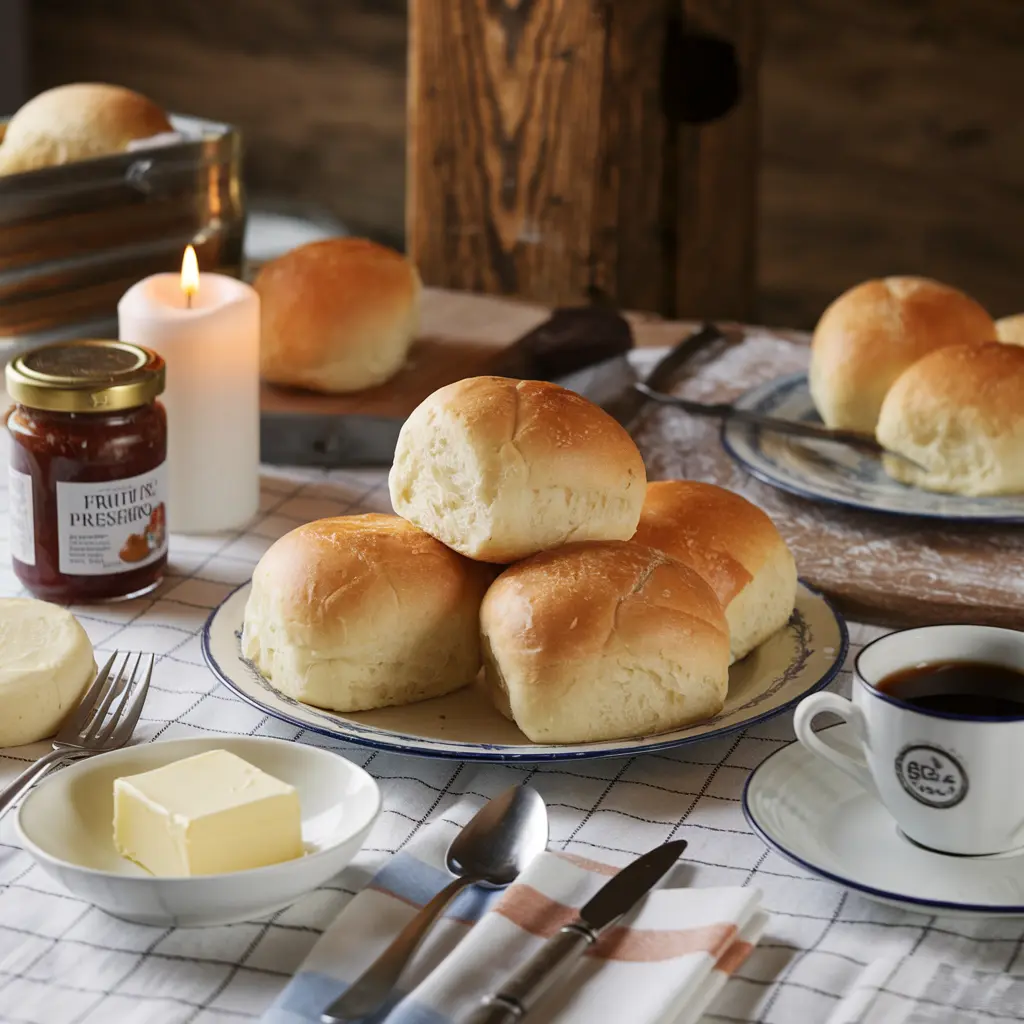
Heading 3: Classic Meal Pairings
- Holiday Dinners:
- Best With: Turkey, roast beef, ham, and gravy-based dishes.
- Tip: Serve warm rolls with a side of herbed butter for an elegant touch.
- Soups and Stews:
- Best With: Hearty soups like chicken noodle, minestrone, and beef stew.
- Tip: Use rolls for dipping or tear them apart for added texture in the soup.
- Barbecue and Grilled Meats:
- Best With: Pulled pork, brisket, or barbecue chicken.
- Tip: Use dinner rolls as sandwich buns for sliders or BBQ sandwiches.
- Pasta Dishes:
- Best With: Lasagna, spaghetti Bolognese, or Alfredo pasta.
- Tip: Add garlic butter to rolls for a perfect pasta side.
Heading 3: Creative Serving Ideas
- Dinner Roll Sandwiches:
- Use rolls to make mini sandwiches with deli meats, cheeses, and condiments. Great for casual gatherings or packed lunches.
- Bread Basket Centerpiece:
- Arrange various types of rolls (classic, herb, and cheese-stuffed) in a decorative bread basket lined with a linen cloth for a stunning dinner table presentation.
- Appetizer Rolls:
- Serve small rolls with a selection of flavored butters, jams, and spreads for a unique appetizer station.
- Sweet Treat Transformation:
- Turn leftover rolls into bread pudding, French toast, or cinnamon sugar bites for a delightful dessert.
Butter and Spread Pairings
- Flavored Butters:
- Herb Butter: Mix softened butter with rosemary, thyme, and garlic.
- Honey Butter: Blend butter with honey and a pinch of salt.
- Maple Cinnamon Butter: Combine butter, maple syrup, and ground cinnamon for a sweet twist.
- Spreads and Dips:
- Cheese Spreads: Serve with cream cheese spreads or pimento cheese.
- Jam & Jelly: Use homemade fruit preserves or store-bought jams.
- Olive Oil & Balsamic Dip: A Mediterranean-inspired dipping sauce.
Perfect Beverages to Serve with Dinner Rolls
- Red Wines: Cabernet Sauvignon or Merlot for rich, savory meals.
- White Wines: Chardonnay or Sauvignon Blanc for lighter dishes.
- Non-Alcoholic: Iced tea, sparkling water, or fruit-infused water for a refreshing accompaniment.
Storing and Reheating Dinner Rolls
To enjoy your dinner rolls for days after baking, proper storage and reheating techniques are essential. Follow these methods to keep your rolls fresh, soft, and delicious.
Heading 3: How to Store Dinner Rolls
- At Room Temperature:
- Best For: Short-term storage (1-2 days).
- How To:
- Allow rolls to cool completely.
- Place them in an airtight container or resealable plastic bag.
- Store in a cool, dry place away from direct sunlight.
- In the Refrigerator:
- Best For: Extending shelf life up to 5-7 days.
- How To:
- Wrap rolls individually in plastic wrap or foil to prevent drying out.
- Store in the refrigerator in an airtight container.
- In the Freezer:
- Best For: Long-term storage (up to 3 months).
- How To:
- Wrap each roll tightly in plastic wrap and place them in a freezer-safe bag or container.
- Label with the storage date for reference.
How to Reheat Dinner Rolls
- In the Oven (Best for Large Batches):
- Temperature: Preheat the oven to 350°F (175°C).
- How To:
- Place rolls on a baking sheet and cover loosely with aluminum foil to prevent drying out.
- Bake for 10-15 minutes until warm.
- Optionally, brush with melted butter before serving.
- In the Microwave (Best for Quick Reheating):
- How To:
- Place one or two rolls on a microwave-safe plate.
- Cover with a damp paper towel to retain moisture.
- Heat on high for 15-20 seconds or until warm.
- How To:
- In the Air Fryer:
- How To:
- Preheat the air fryer to 325°F (160°C).
- Place rolls in the air fryer basket in a single layer.
- Heat for 5-7 minutes, checking frequently.
- How To:
Tips for Maintaining Freshness
- Avoid Storing in the Refrigerator Without Wrapping: Bread can dry out quickly in the refrigerator due to cold air circulation.
- Refresh Stale Rolls: Sprinkle a bit of water on the rolls and bake them in a preheated oven for 5-10 minutes.
- Freeze Dough Instead: Consider freezing unbaked dough balls for a fresher, just-baked taste when needed.
FAQs About Dinner Rolls
Here are some frequently asked questions about making, storing, and serving dinner rolls, along with expert answers to ensure baking success.
1. Why Did My Dinner Rolls Turn Out Dense?
- Answer: Dense rolls usually result from under-kneading the dough, inactive yeast, or insufficient proofing time. Ensure the yeast is properly activated and allow the dough to rise until it doubles in size before baking.
2. How Can I Make My Rolls More Fluffy?
- Answer: Use bread flour for higher gluten content, which creates a light, airy texture. Knead the dough well and allow it to rise in a warm environment for optimal fluffiness.
3. Can I Use Instant Yeast Instead of Active Dry Yeast?
- Answer: Yes, instant yeast can be substituted. Skip the yeast-proofing step and mix it directly with the dry ingredients. However, monitor the dough’s rise closely, as instant yeast works faster.
4. How Long Should I Let the Dough Rise?
- Answer: The first rise typically takes 1-2 hours or until the dough doubles in size. The second rise after shaping the rolls should take 30-45 minutes. Rising time can vary based on room temperature.
5. Can I Make the Dough Ahead of Time?
- Answer: Yes, you can refrigerate the dough after the first rise for up to 24 hours. Allow it to come to room temperature before shaping and baking. This makes meal prep more manageable.
6. How Do I Keep Dinner Rolls Warm for Serving?
- Answer: To keep rolls warm, place them in a bread basket lined with a clean towel and cover them with another towel. Alternatively, place them in a low-temperature oven (around 200°F or 93°C) for short periods.
7. Can I Freeze Baked Dinner Rolls?
- Answer: Yes, baked dinner rolls freeze well for up to three months. Wrap them tightly in plastic wrap and place them in a freezer-safe bag. Reheat directly from frozen in the oven for the best results.
8. What’s the Best Way to Add Extra Flavor to Rolls?
- Answer: Add ingredients like garlic powder, fresh herbs (rosemary, thyme), shredded cheese, or cinnamon sugar. You can also brush the rolls with flavored butter or sprinkle with sesame or poppy seeds before baking.
9. Why Didn’t My Rolls Brown on Top?
- Answer: Lack of browning may be due to an oven set too low or skipping the egg wash or butter brushing step. Apply an egg wash or melted butter before baking for a golden-brown finish.
10. Can I Use Plant-Based Ingredients for Vegan Rolls?
- Answer: Absolutely! Substitute dairy milk with plant-based alternatives like almond or soy milk, replace butter with vegan margarine, and use flax eggs (1 tbsp ground flaxseed + 3 tbsp water) instead of eggs.
Conclusion
Dinner rolls are a timeless favorite that add warmth and comfort to any meal. With the right ingredients, techniques, and a bit of practice, you can create soft, fluffy, and flavorful rolls that impress family and guests alike. From classic holiday dinners to everyday meals, these versatile rolls pair perfectly with soups, stews, roasts, and even sweet spreads.
By following this comprehensive guide, you can master every step of the process — from kneading and proofing to baking and storing. Experiment with different flavors, textures, and presentation styles to make your rolls truly unique. With these tips and tricks, your homemade dinner rolls will become a cherished addition to your recipe collection.

